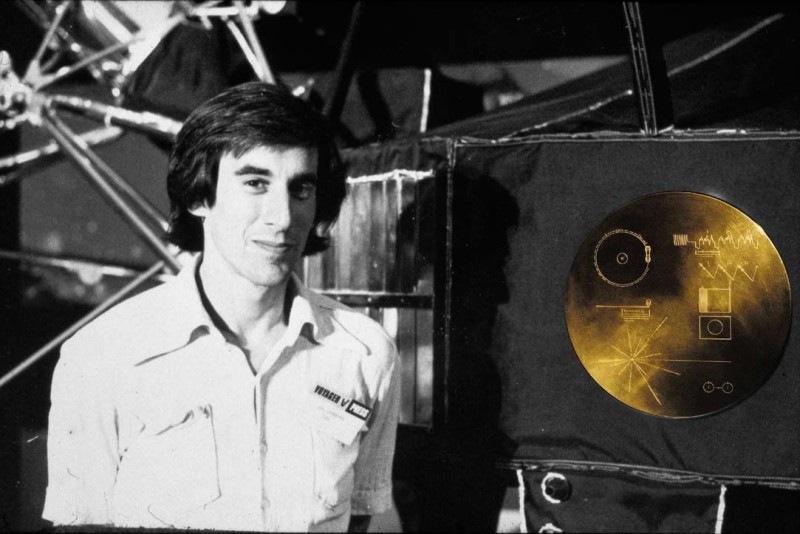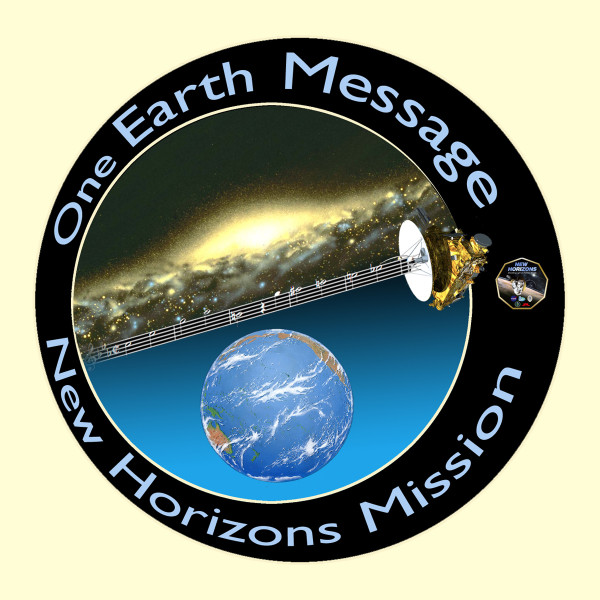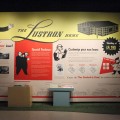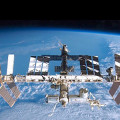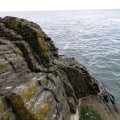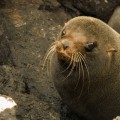The Voyager Golden Record: A chat with the Golden Record’s artist, Jon Lomberg
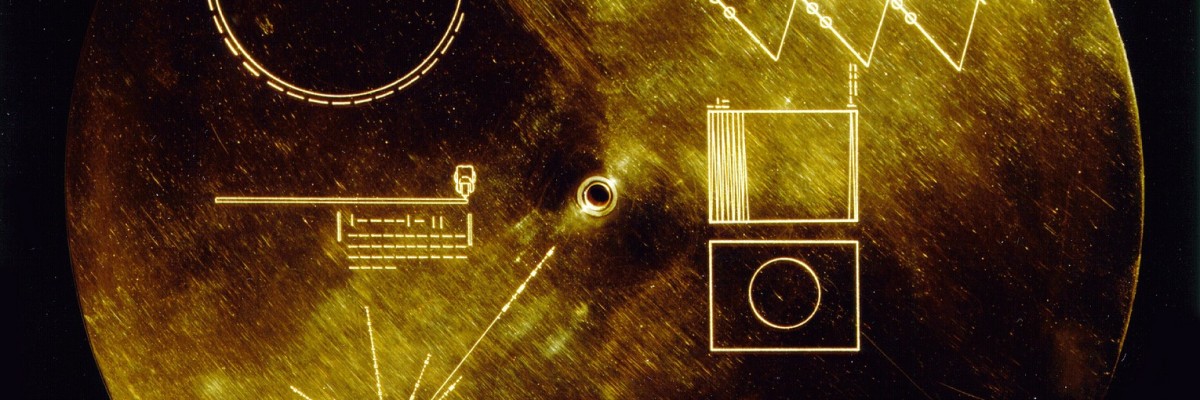
If you had to send a message that could explain all of humanity, but not just humanity – the other life on Earth, too – and you had a limited amount of space to do it in, what would you include? Why? That’s the question that faced a small team of creative minds in the United States in 1977. Gathered by scientists Carl Sagan and Frank Drake, they had 6 weeks to decide what form their message would be in and what it would include. They also had to get the copyrights for all materials that required them, and produce the actual message artifact…no small task.
By the end of the project, they were all sleep deprived. But the Voyager spacecraft set off with the Golden Record attached, carrying a message to neighbors we aren’t sure we have. It’s a message that will most likely be delivered well after our existence on this planet ends, but at least our cosmic neighbors, if they are out there, might learn that they are not alone.
The message is written on a copper record that was coated with gold to protect it from the elements. It holds visual images of life, music from around the world, and even mathematical equations and letters from politicians as varied as the former UN leader (and Nazi SS – a fact that was unknown at the time) Kurt Waldheim and President Jimmy Carter of the United States.
Jon Lomberg wasn’t even 30 when the record was made. He was the Design Director, and one of several young team members. Despite already being Sagan’s artistic collaborator on numerous projects, he still remembers being uniquely humbled but excited to be a part of the Golden Record’s creation. This month, Travel Thru History chatted with him to hear about his experiences. It turns out, we were just in time. Lomberg is currently working on a book about his participation, as well as a modern version of the record – the One Earth Message.
TTH: What was it like to be a part of a team whose job was to present humanity to any extraterrestrial neighbors we might have?
JL: Well, as you can imagine, it was a once in a lifetime opportunity. I felt very privileged to have been asked, and that Carl Sagan thought I had something to contribute. All artists like to do things that last, and I got to do something that will last a thousand million years.
It was one of those things that you think “Don’t let me screw this up.” If we selected offensive material, it would have been a disaster. But the verdict of history has been that we did a pretty good job. What all of us working on the project had was a deep and long-standing interest in how we might communicate with extraterrestrials.
We all brought something new to the table, and we got some diversity of point of view, although we were all white, college-educated Americans. We did try to make this a globally-inclusive message, something that was very important to Carl, and an axiom that I’ve used in all of my work from that point on.
TTH: Can you tell us about the material choices for the Golden Record itself? Why the golden copper disc?
JL: It turns out that none of our digital stored messages are any good as long-term archives. Books, stone tablets, and the like are much less susceptible to degradation. A phonograph made of metal will stay playable until the disc itself is physically damaged by the conditions in space. Frank Drake, who had worked with Carl to make the Pioneer Plaque (the first interstellar message artifact), said that for the same weight and space allowance we could make a metal phonograph record, which could store a lot more information than a plaque could.
Copper was chosen because it was a durable metal and was in fact the material used in the production of masters for ordinary vinyl records. A thin gold coating, prevents chemical weathering. Put the whole thing in a box with directions of how to play a record, and it will last until erosion destroys the box. Occasionally a tiny fleck of dust will hit the box and damage it, and calculations suggest that it would take a billion years to wear through the box another billion years to destroy side A, the outward facing side. Side B, with all the pictures as well as music, would survive another billion years.
The durability was a plus, and unlike the digital information systems we’re used to using now, phonograph records are easy to play. You can figure out how to play one with a safety pin, a pencil and your hand. Stick the pencil in the hole and spin the disk. Put the pin in the spinning disk and you’ll hear it. We even supplied the needle in the box with the record. The ease of getting to the content was a strong plus.
TTH: How were the images selected?
JL: Frank Drake invented a new method storing video signals on an audio LP. That’s how we were able to have pictures at all. He and Carl Sagan asked their colleagues “If you were going to send a photograph of Earth, what would you send pictures of?” Unsurprisingly, all agreed that there should be a lot of pictures of family, children, cities, landscapes, and of course them myriad forms of life on Earth. Some of our consultants had specific suggestions. Philip Morrison of MIT suggested a page from Isaac Newton’s book with humanity’s first diagram of how to launch a cannonball into space around the Earth.
We had only 6 weeks to do the project, with the finished object ready to hand NASA. It was a crazy rush. We had to get copyrights. There was a whole rights acquisition aspect to it. We didn’t have anything to offer except the chance to be included.
In my role in working with Frank on selecting the images, I was thinking of three factors. They had to be global images. It wasn’t just the USA or NASA we represented, it was all of mankind. I wanted the pictures to tell a story, and wanted to make sure that key things like the human hand or the importance of raising human children were repeated in the message. These were not just a bunch of random snapshots.
I also had a hand in the sound montage. I proposed that mix also tell a story, evolutionary in nature – nature, the biosphere, and human sounds. The same kind of sequence as used in the images.
It would have been nice to have a 1:1 relationship between images and sounds, but our time was limited. Since we believe in Darwinian evolution, another planet would likely have gone through the same sequence. It’s a story that is our story, but it may also be everybody’s story.
TTH: What was the most challenging moment for you, personally?
JL: I don’t know that there was a single moment that was most challenging. It was multi-tasking. I hardly slept. Ideas kept popping into my head. There was no guidebook on how to do it – we made it up as we went along, and that was a challenge. The short period of time we had to do it in was also a challenge.
I think that short production period made it easier to get NASA to accept it. If we’d had more time, it might never have gotten done. Carl was a pretty smart guy, I think he did it that way because it gave us the best chance of getting NASA to approve it, and he was right.
TTH: You’re working on something similar now, right? Can you tell us about your current project?
JL: The Voyager spacecraft are now out at the outer edge of the solar system. The fifth object to leave is the New Horizons spacecraft, launched in 2007. It was going to Pluto and then out of the system. I thought they would make an artifact like the Golden Record for it, but they didn’t. It seemed to me a missed opportunity, but then I thought that we could make a message here on Earth and put it as a digital message on the spacecraft’s computer. I asked Alan Stern, the mission director, if this was a crazy idea, but he thought it was a good idea and supported it. With his encouragement I started the One Earth Message project.
In 1977, a handful of us spoke for the human race. Now, the internet makes it possible for everyone around the world to participate. It’s a crowdsourced message. The people of earth decide what to send. I was privileged to have that chance, and now everybody can have that chance. We also hope to have kinds of information we were unable to include on the Voyager Record, such as 3D files and software.
Would ETs enjoy Sudoku? Would they find our favorite molecules interesting? DNA , sure, but how about chocolate? Could humans make a better contribution to the Galaxy? Biochemistry is biochemistry, and here on Earth molecules made in plants can have powerful effect on human senses and thought.
Perhaps they’ll trigger similar responses in other beings.
We expect to send it as part of the Extended Mission that will take the spacecraft to another strange, new world to explore in the Kuiper Belt in 2019. I said Voyager was a once in a lifetime opportunity, and I never expected it to happen twice. It’s tremendously exciting to be working on another one.
TTH: Over the years, you’ve been interviewed plenty of times. What’s one question you wish someone had asked, but never has? How would you answer it, and why?
JL: What a good question! That’s a stumper. I have to think about that…
People have done a pretty good job at poking at it from every angle. I think pretty much all of the questions have been asked. I’m relieved that in general all of the writers about the Voyager record have implicitly or directly implied that we did a pretty good job. The questions that I haven’t gotten and expected to get were related to our choices – they were naturally selective, and I thought more people would be upset that their particular favorites were not represented. Maybe everyone realizes how small the selection had to be.
TTH: How did the Golden Record experience change your career?
JL: It certainly settled the question as to whether I did something that would last. It was humbling. I wasn’t even 30 when I did it, and it will be the first line on my obituary. This is going to be what will be most remembered of my work. It kind of humbled me, and it also maybe took away some of the worry about leaving something lasting in my work. It gave me confidence that I didn’t need to prove anything to anybody. I was able to continue working and doing what I love to do.
TTH: If you could change something on the record (apart from making it a global collaboration as you’re doing now), what would it be? Why?
JL: The one thing I would change is that I proposed that some Bob Marley would be included. At the time, reggae music and Bob Marley were not at cultural icon status. I think that it is a very popular music in the 3rd world; what people are listening to right now. Including it would have included a large group that otherwise would not feel so well represented.
There’s nothing on the record that I would take off, but if I could add some things that would be one thing I would add.
I take it back. There’s one thing that should not be there. The greeting from Kurt Waldheim, whose past as an SS officer was not known at the time. Having made such an effort to sanitize the Voyager record, we lead it off with a Nazi. Even after attempting to present the best, what’s inside snuck out. Having him on it also led to other politicians being included.
Sagan and Drake decided there were to be no pictures of anything bad about us [humans]. Did that make our message less honest? Their rationale was that when you meet someone, you put your best foot forward, and that should be how the Galaxy remembers us. That’s probably been the biggest criticism of the Record. So one of the first questions I asked our Advisory Board was if we should adopt the same policy, and the response was almost unanimously “no.” At this point in our history, to do so would be dishonest.
The One Earth Message that we hope to upload to the spacecraft will attempt to solve the many challenges in making a true 21st Century “Selfie of Earth”. People from 140 countries so far have expressed their support, and we are developing a global network of people who will make sure that their piece of the planet has a chance to contribute. We welcome potential individual and institutional patrons who want to assist us achieve this loft goal. See our website oneearthmessage.org or write us at newhorizonsmessage@gmail.com
You’ve heard Jon’s story. You can check out the contents of the first Golden Record here, but before you do, tell us what you would put on the One Earth Message today. Would you ‘sanitize’ it, or tell the whole story of who we are – wars and all? Why?




